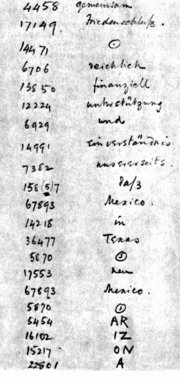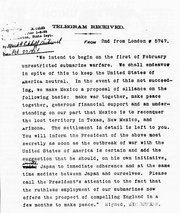Zimmermann Telegram
|
|
- For other uses of "Zimmermann", see Zimmermann (disambiguation)
The Zimmermann Telegram was a telegram dispatched by the Foreign Secretary of the German Empire, Arthur Zimmermann, on January 16, 1917, to the German ambassador in Mexico, Heinrich von Eckardt, at the height of World War I. It instructed the ambassador to approach the Mexican government with a proposal to form an alliance against the United States. It was intercepted by the British and its contents hastened the entry of the United States into the war.
| Contents [hide] |
The telegram
Zimmermann's message included proposals for a German alliance with Mexico, while Germany would still try to maintain a state of neutrality with the United States. If this policy were to fail, the note suggested, the Mexican government should make common cause with Germany, try to persuade the Japanese government to join the new alliance, and attack the US. Germany on its part would promise financial assistance and the restoration of its former territories of Texas, New Mexico and Arizona to Mexico (lost in the US-Mexico war of 1846-1848).
The Mexican answer
Later, a general assigned by Mexico's president, Venustiano Carranza, assessed the realities of a Mexican takeover of their former provinces and came to the conclusion that it would not work. Taking over the three states would almost certainly cause future problems and possibly war with the US; Mexico would also be unable to accommodate a large Anglo population within its borders; and Germany would not be able to supply the arms needed in the hostilities that would surely arise. Carranza declined Zimmermann's proposals on April 14, by which time the US had declared war on Germany.
British interception

The telegram was intercepted and decrypted enough to get the gist of it by codebreakers Nigel de Grey and William Montgomery of the British Naval Intelligence unit, Room 40, under Admiral William R. Hall. This was made possible because the code the Foreign Office used (0075) had been partially cryptanalyzed using, among other techniques, captured plaintext messages and a codebook for an earlier version of the cypher captured from Wilhelm Wassmus, a German agent working in the Middle East.
The British government, which wanted to expose the incriminating telegram, faced a dilemma: if it baldly produced the actual telegram, the Germans would suspect that their code was broken; and if it did not, it would lose a promising opportunity to draw the United States into World War I – the message was sent during a period when anti-German feeling in the United States was running particularly high, following the loss of some two hundred US lives to German submarine attacks.
There was a further problem too — they could not simply confidentially show it to the United States government either. Because of its importance, the message had been sent from Berlin to the German ambassador in Washington, Johann von Bernstorff, for onward transmission to their ambassador in Mexico, von Eckardt, by three separate routes. The British had obtained it from just one of these — the Americans had given Germany access to their private diplomatic telegraph in an effort to encourage President Wilson's peace initiative. The Germans were not afraid of using it because the messages were encrypted and because as a matter of principle the United States did not at that time read other countries' diplomatic correspondence nor did they have any code-breaking capability such as Britain had. The telegraph cable went from the US Embassy in Berlin to Copenhagen and then via submarine cable to the United States via Britain (where it was monitored). For the British to reveal the source of the telegram to the United States would have meant also admitting to the American government that they had tapped US diplomatic communications.
The British solution
Ztel1b.jpg
The British government guessed that the German Embassy in Washington would send the message on to the embassy in Mexico via the commercial telegraph system, and therefore a copy would exist in the public telegraph office in Mexico City. If they could get a copy, they could pass it on to the United States government stating that they had discovered it through espionage in Mexico. Therefore, they contacted a British agent in Mexico, known only as Mr. H., who managed to get a copy. To the delight of the British code breakers, the message had been sent from the German embassy in Washington to Mexico using the older cypher in the Wassmus codebook and could therefore be completely decrypted — presumably because the German embassy in Mexico did not have the latest codebook.
The telegram was delivered by Admiral Hall to the British Foreign Minister, Arthur James Balfour, who in turn contacted the US ambassador in Britain, Walter Page, and delivered the telegram to him on February 23. Two days later he relayed it to President Woodrow Wilson.
The effect in the United States
The popular sentiment in the United States at that time was generally as anti-Mexican as it was anti-German. General John J. Pershing had long been chasing bandit-cum-revolutionary Pancho Villa, who had carried out several cross-border raids. This was a great expense to the US government, and Wilson was leaning towards discontinuing the search until new elections were held in Mexico, a new government installed, and a new constitution promulgated (a constitutional convention, which would adopt the 1917 Constitution of Mexico, was underway at the time). News of the telegram exacerbated tensions between the USA and Mexico, since such a treaty, if in place, would have hindered the election of a new Mexican government more friendly to US interests.
On March 1, the US government gave the plaintext of the telegram to the press. Initially the American public believed the telegram to be a fraud designed to bring them into the war on the Allied side. This opinion was bolstered by German, Mexican and Japanese diplomats, and by the American pacifist and pro-German lobbies, who all denounced the telegram as a forgery.
Arthur Zimmermann's speech
However, in an unexpected move, Zimmermann confirmed its authenticity on March 3 and again in a speech on March 29, 1917. The speech was intended to explain his side of the situation. He began that he had not written a letter to Carranza but had given instructions to the German ambassador via a "route that had appeared to him to be a safe one".
He also said that despite the submarine offensive, he had hoped that the USA would remain neutral. His proposal to the Mexican government were only to be carried out if the US declared war, and he believed his instructions to be "absolutely loyal as regards the US". In fact, he blamed President Wilson for breaking off relations with Germany "with extraordinary roughness" after the telegram was intercepted, and that therefore the German ambassador "no longer had the opportunity to explain the German attitude, and that the US government had declined to negotiate".
There was an honesty in his speech since he would have had occasion to reflect on the impact of the telegram and its after effects in the meantime, yet still he was prepared to present its original ideas. However, it also revealed he was seriously misinformed about the real strength of the United States vis-à-vis its southern neighbour, but that was the fault of the German intelligence services.
War declared
Although the telegram began by stating that Germany was most interested in maintaining American neutrality while attacking its shipping, this confirmation of its basic enmity evoked an outpouring of anti-German sentiment. Wilson responded to this manifestation of German hostility towards the US by asking Congress to arm American ships so that they could fend off potential German submarine attacks. A few days later, on April 2, 1917, Wilson asked Congress to declare war on Germany. On April 6, 1917, Congress complied, bringing the United States into World War I.
German submarines had previously attacked US ships near the British Isles, so the telegram was not the only cause of US entry into the war; it did, however, play a critical role in swaying US public opinion. It was perceived as especially perfidious that the telegram was first transferred from the US embassy in Berlin to the German embassy in Washington before being passed on to Mexico. Once the American public believed the telegram to be real, it became all but inevitable that the USA would join the Great War.
See also
- Arthur Zimmermann the German foreign Minister during WWI
References
- Room 40: British Naval Intelligence, 1914-1918, by Patrick Beesly. New York: Harcourt, Brace, Jovanovich, 1982 ISBN 0-15-178634-8
- On Secret Service East of Constantinople, by Peter Hopkirk. Oxford University Press, 1994 ISBN 0-19-280230-5
- The Zimmermann Telegram, by Barbara W. Tuchman, Ballantine Books, 1958 ISBN 0-345-32425-0
- The Zimmermann Telegram of January 16, 1917 and its Cryptographic Background by William F. Friedman and Charles J. Mendelsohn: . War Department, Office of the Chief Signal Officer, Washington, GPO, 1938de:Zimmermann-Depesche
he:מברק צימרמן fr:Télégramme Zimmermann it:Telegramma Zimmermann nl:Zimmermanntelegram

